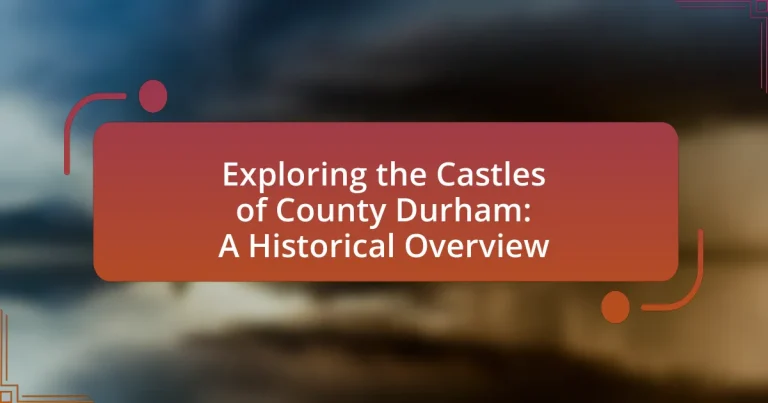The article focuses on the notable castles of County Durham, including Durham Castle, Barnard Castle, and Raby Castle, highlighting their historical significance and architectural styles. It examines how historical events, such as the Norman Conquest and the Wars of the Roses, shaped the design and function of these castles, which served as military strongholds, residences, and centers of administration. The article also explores the cultural impact of these castles on local folklore and tourism, as well as resources available for visitors to learn more about their rich histories.

What are the notable castles in County Durham?
The notable castles in County Durham include Durham Castle, Barnard Castle, and Raby Castle. Durham Castle, a UNESCO World Heritage Site, dates back to the 11th century and serves as a college for Durham University. Barnard Castle, built in the 12th century, is known for its impressive ruins and historical significance as a stronghold during the border conflicts. Raby Castle, constructed in the 14th century, is one of the best-preserved medieval castles in England and features extensive grounds and gardens. These castles reflect the rich history and architectural heritage of County Durham.
How did historical events shape the castles of County Durham?
Historical events significantly influenced the design and function of the castles in County Durham. The Norman Conquest of 1066 led to the establishment of many castles as symbols of power and control, with Durham Castle being a prime example, built to assert Norman dominance over the region. Subsequent conflicts, such as the Wars of the Roses and the English Civil War, prompted modifications to these structures for defensive purposes, resulting in adaptations like thicker walls and fortified gates. Additionally, the rise of the Bishopric of Durham in the medieval period transformed some castles into ecclesiastical strongholds, reflecting the intertwining of religious and political power. These historical contexts illustrate how the castles evolved in response to the shifting dynamics of authority and conflict in County Durham.
What role did the Norman Conquest play in castle construction?
The Norman Conquest significantly influenced castle construction in England, particularly in County Durham, by introducing a systematic approach to fortification. Following the conquest in 1066, the Normans built motte-and-bailey castles to establish control over newly acquired territories, with many constructed in strategic locations to assert dominance and provide military defense. Historical records indicate that over 1,000 castles were built in England during the 11th century, with notable examples in County Durham, such as Durham Castle, which was constructed in 1072. This shift in architectural style and military strategy marked a transition from earlier fortifications to more robust stone structures, reflecting the Normans’ emphasis on power and territorial control.
How did the Wars of the Roses influence castle architecture?
The Wars of the Roses significantly influenced castle architecture by prompting the construction of more fortified and defensible structures. During this period of civil conflict between the houses of Lancaster and York, castles were redesigned to enhance their military capabilities, incorporating features such as thicker walls, larger towers, and improved gatehouses. For instance, the need for stronger defenses led to the addition of artillery platforms and the use of crenellations, which allowed for better protection against sieges. This architectural evolution reflected the turbulent political landscape of the time, as noble families sought to secure their power and protect their territories from rival factions.
What architectural styles are represented in County Durham’s castles?
County Durham’s castles primarily represent Norman, Gothic, and Renaissance architectural styles. Norman architecture is evident in structures like Durham Castle, characterized by its massive stone walls and rounded arches, reflecting the military function of these early castles. Gothic elements are showcased in the intricate designs and pointed arches found in buildings such as Barnard Castle, which highlight the transition to more decorative styles during the medieval period. Additionally, Renaissance influences can be seen in the later modifications and embellishments of some castles, indicating a shift towards more classical aesthetics. These architectural styles collectively illustrate the historical evolution and cultural significance of County Durham’s castles.
What features distinguish Norman castles from later styles?
Norman castles are distinguished from later styles primarily by their use of motte-and-bailey design, thick stone walls, and a focus on defensive features. The motte-and-bailey structure consists of a raised earthwork (motte) topped with a wooden or stone keep, alongside an enclosed courtyard (bailey) that served various functions. This design was prevalent in the 11th and 12th centuries, reflecting the military needs of the Norman conquest. Additionally, Norman castles often featured rounded towers and a lack of decorative elements, contrasting with later Gothic styles that emphasized verticality and ornamentation. Historical examples, such as the Tower of London and Durham Castle, showcase these characteristics, reinforcing the distinct architectural identity of Norman castles compared to their successors.
How did the Gothic revival impact castle design in the region?
The Gothic revival significantly influenced castle design in County Durham by reintroducing medieval architectural elements and aesthetics. This movement, which gained momentum in the 19th century, led to the incorporation of pointed arches, intricate stone carvings, and battlements in new constructions and restorations of existing castles. Notable examples include the redesign of Raby Castle and the construction of Auckland Castle, where the revivalist style emphasized verticality and ornate detailing, reflecting a romanticized view of the medieval past. The impact of the Gothic revival is evident in the way these structures were intended to evoke a sense of history and grandeur, aligning with the broader cultural movement that sought to reconnect with national heritage.

Why are the castles of County Durham historically significant?
The castles of County Durham are historically significant due to their roles in the defense and governance of the region during the medieval period. Notably, Durham Castle, built in the 11th century, served as a fortress and residence for the Bishops of Durham, reflecting the power of the church in political matters. Additionally, the castles exemplify Norman military architecture and illustrate the feudal system’s influence in England, with structures like Barnard Castle and Raby Castle showcasing the wealth and status of their owners. These castles also played pivotal roles during conflicts such as the Wars of the Roses, further cementing their importance in English history.
What functions did these castles serve throughout history?
Castles throughout history served multiple functions, primarily as fortifications, residences, and symbols of power. Initially, they were built for defense against invasions and attacks, featuring thick walls and strategic locations, such as the Norman castles in County Durham that were established after the Norman Conquest in 1066. Over time, castles evolved into luxurious residences for nobility, showcasing wealth and status, as seen in the transformation of Durham Castle from a military stronghold to a residence for the Bishop of Durham. Additionally, castles functioned as administrative centers, where local governance and justice were exercised, reflecting their role in the feudal system. Historical records indicate that many castles, including those in County Durham, were pivotal in controlling land and resources, thus reinforcing the power of their owners during the medieval period.
How did castles serve as military strongholds?
Castles served as military strongholds by providing fortified structures that offered defense against attacks and a strategic vantage point for surveillance. Their thick stone walls, towers, and moats were designed to withstand sieges and assaults, making them difficult for enemies to penetrate. For example, the castles in County Durham, such as Durham Castle, were built during the Norman Conquest to assert control over the region and protect against invasions. These fortifications often included features like arrow slits for archers and drawbridges for controlled access, enhancing their defensive capabilities. Historical records indicate that castles played a crucial role in regional power dynamics, serving as bases for military operations and symbols of authority.
In what ways did castles function as centers of administration?
Castles functioned as centers of administration by serving as the primary locations for governance, justice, and military organization. They housed the lord and his officials, who managed local affairs, collected taxes, and enforced laws. For example, in County Durham, castles like Durham Castle were pivotal in overseeing the surrounding lands, facilitating the administration of the Bishopric, and acting as a base for military operations. Additionally, castles often contained courtrooms where legal disputes were settled, reinforcing their role in maintaining order and authority within the region.
What cultural impacts have the castles had on County Durham?
The castles in County Durham have significantly influenced local culture by serving as historical landmarks that embody the region’s heritage and identity. These structures, such as Durham Castle and Barnard Castle, have played pivotal roles in shaping community narratives and fostering a sense of pride among residents. For instance, Durham Castle, a UNESCO World Heritage Site, has been integral to the educational landscape as it houses Durham University, thereby promoting academic and cultural activities. Additionally, the castles attract tourism, contributing to the local economy and encouraging the preservation of traditions and crafts associated with the region’s history. The presence of these castles has also inspired local festivals and events, further embedding them into the cultural fabric of County Durham.
How have castles influenced local folklore and legends?
Castles have significantly influenced local folklore and legends by serving as the backdrop for tales of heroism, tragedy, and supernatural events. For instance, the presence of castles like Durham Castle has inspired stories of ghostly apparitions and legendary figures, such as the tale of the “White Lady,” believed to haunt the castle grounds. These narratives often reflect historical events or the lives of notable individuals associated with the castles, thereby embedding them into the cultural identity of the region. Additionally, the architectural grandeur and historical significance of these structures contribute to their role as focal points for local myths, enhancing community ties and preserving cultural heritage through storytelling.
What role do castles play in modern tourism in County Durham?
Castles play a significant role in modern tourism in County Durham by attracting visitors interested in history, architecture, and culture. These historical structures, such as Durham Castle and Raby Castle, serve as key attractions that enhance the region’s tourism appeal. In 2019, tourism in County Durham generated approximately £1.5 billion, with heritage sites like castles contributing substantially to this economic impact. The castles offer guided tours, educational programs, and events that engage tourists, thereby promoting local heritage and supporting the economy.

How can visitors explore the castles of County Durham today?
Visitors can explore the castles of County Durham today by participating in guided tours, attending special events, and utilizing visitor information centers. Many castles, such as Durham Castle and Raby Castle, offer structured tours that provide historical insights and access to areas not typically open to the public. Additionally, events like medieval reenactments and seasonal festivals enhance the experience, allowing visitors to engage with the history in an interactive manner. Visitor information centers provide maps, brochures, and expert advice to help plan the exploration of these historic sites effectively.
What are the best practices for visiting these historical sites?
The best practices for visiting historical sites, such as the castles of County Durham, include planning your visit in advance, respecting the site’s rules, and engaging with the history. Planning involves checking opening hours, booking tickets online, and researching the site’s historical significance to enhance your experience. Respecting rules includes following guidelines regarding photography, staying within designated areas, and not touching artifacts, which helps preserve the site for future visitors. Engaging with history can be achieved by participating in guided tours or using audio guides, which provide context and enrich understanding. These practices ensure a respectful and informative visit, contributing to the preservation of these important cultural landmarks.
What should visitors know about guided tours of the castles?
Visitors should know that guided tours of the castles in County Durham provide in-depth historical insights and access to areas not typically open to the public. These tours often include knowledgeable guides who share stories about the castles’ architecture, historical significance, and notable events. For example, Durham Castle, a UNESCO World Heritage Site, offers tours that highlight its Norman architecture and role in the history of the region. Additionally, many tours are designed to accommodate various interests, from family-friendly experiences to more specialized historical explorations, ensuring a comprehensive understanding of the castles’ heritage.
How can visitors engage with the history of the castles during their visit?
Visitors can engage with the history of the castles during their visit by participating in guided tours that provide detailed narratives about the castles’ historical significance and architectural features. These tours often include access to areas not open to the general public, allowing visitors to experience the castles’ history firsthand. Additionally, many castles offer interactive exhibits and reenactments that illustrate historical events, enhancing the educational experience. For example, Durham Castle, a UNESCO World Heritage Site, features exhibitions that showcase its medieval history and role in the region, providing visitors with context and deeper understanding of its past.
What resources are available for learning more about County Durham’s castles?
Resources for learning about County Durham’s castles include local history books, online databases, and guided tours. Notable books such as “The Castles of County Durham” by David A. Smith provide detailed historical insights and architectural analysis. Online platforms like the Historic England website offer extensive information on the heritage and preservation of these sites. Additionally, organizations such as the Durham County Council provide resources and information on visiting and exploring the castles, including maps and educational materials. These resources collectively enhance understanding of the historical significance and architectural features of County Durham’s castles.
Where can visitors find historical literature on the castles?
Visitors can find historical literature on the castles of County Durham at local libraries, historical societies, and dedicated heritage centers. For instance, the Durham County Record Office offers a wealth of archival materials and publications related to the region’s castles. Additionally, the University of Durham’s library contains extensive resources on local history, including books and journals focused on the castles. These institutions provide access to both primary and secondary sources, ensuring that visitors can explore the rich history of County Durham’s castles in depth.
What online resources provide insights into the castles’ histories?
Online resources that provide insights into the histories of castles include websites such as Historic England, which offers detailed information on the architectural and historical significance of various castles, including those in County Durham. Additionally, the National Trust provides resources on the history and preservation of castles under its care, while local heritage websites, such as the Durham County Council’s site, offer specific historical context and visitor information about County Durham’s castles. These platforms often include archival materials, historical documents, and expert articles that enhance understanding of the castles’ roles in history.




